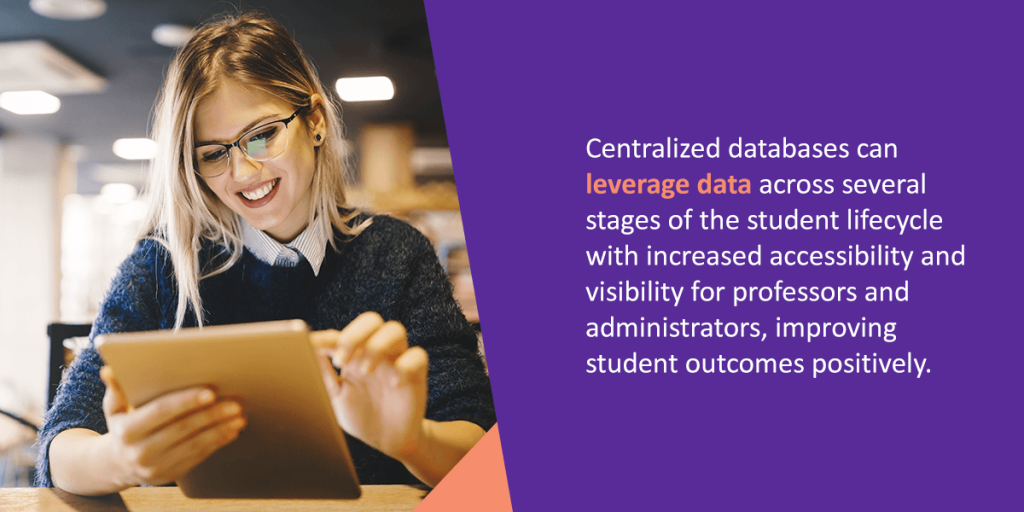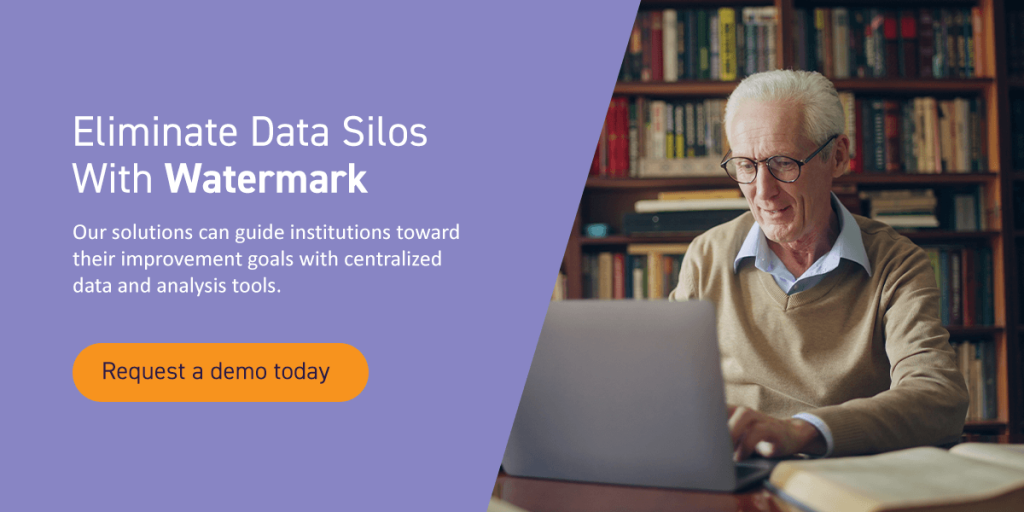




Higher education institutions dedicate processes to supporting student success and have a sincere interest in demonstrating their institutional effectiveness. Many schools adopt some form of technology to support data collection and analytics but do not have the right strategies in place to optimize data collection. To that end, the ed tech industry has come forward with purpose-built software focused on particular areas of concern, such as assessment or curriculum management. It has been a great leap forward, but one that has come with an unanticipated consequence — data silos.
Data silos occur when teams, departments, and programs store data sets and information in separate systems, making them inaccessible to others using different platforms. The sheer number of solutions used on campus has multiplied, and higher education has recognized the issue and turned to ed tech providers for help in overcoming data silos. The need for convergence can provide various benefits, including:
Fortunately, many schools are opting for centralized solutions, which promise to bring campus data together for greater insights. Here, we’ll look at the current state of data on campus, consider the challenges of using siloed data, define a vision of educational data solutions, and discuss how institutions are bringing data together to realize the great promise of better educational attainment and student outcomes.
Students, faculty, administrators, and other stakeholders use a growing number of disparate point solutions to answer specific sets of questions or operationalize specific processes. Many of these solutions fulfill their mission while capturing a segment of campus data that can’t easily be shared across the institution. However, point solutions present two additional significant challenges:
For example, a college dean who carries a teaching load, coordinates their department’s reporting, and serves on several cross-departmental committees is responsible for many processes and tasks, including:
These tasks occur in separate systems with distinct workflows and notification systems. As a result, the dean might spend hours managing each process while juggling the demands of teaching, mentorship, and administration. What this dean and many others on campus could use is a centralized system that eliminated data silos.
Centralized databases can leverage data across several stages of the student lifecycle with increased accessibility and visibility for professors and administrators, improving student outcomes positively. Learning management systems (LMS) and student information systems (SIS) each provide essential insight into a specific area of your institution.

A centralized system will provide the most complete view of your institution. It will reveal how your work contributes to student outcomes, bringing together the full range of data from your LMS, SIS, and human resources (HR) system, as well as software addressing specific needs, such as assessment and course evaluation.
We now take LMS software for granted. LMS software evolved from point solutions for grade books and file sharing. SIS came into common use later. Together, they have paved the way for more comprehensive systems that capture a much wider swath of data in support of broader goals than those served by LMS and SIS, such as improving student success and informing decision-making.
By bringing together data from assessment, faculty activity reporting, curriculum and catalog management, course evaluation, and more, centralization will virtually eliminate redundancy and provide a unified source of data that institutions can use to inform decision-making and improve learning outcomes. Institutions looking to gain the advantages of a centralized platform should begin planning their transition from point solutions.
Centralizing and integrating campus data is no small undertaking, but pivotal early steps are underway in higher ed technology. The increased visibility can strengthen decisions for initiatives backed by data. When individuals can all look at the same data set, you boost reliability, since everyone can ensure they have access to the most recent version.
In addition, centralized systems offer more information to instructors for the courses they teach and to administration for the courses they oversee. Platforms gather indirect measures of assessment for each program outcome tied to a course. They tie student responses back to assessment and capture them in a single database to inform a range of institutional processes, including program review, faculty review, and accreditation reporting.
These point-to-point integrations are leading the way to educational intelligence platforms where multiple solutions share a common data structure that allows for deeper inquiry. Similarly, easier user experiences are now emerging. Unified sign-in and navigation reduce task switching for users and pave the way for streamlined interfaces so that moving between tasks feels seamless, just as it does in the Google suite. Key benefits include increasing participation and engagement with the systems.
Let’s return to the college dean example. Imagine that the dean logs into a unified system that streamlines workflows and surfaces meaningful insights so they see a dashboard with summary information relevant to their role, including:
Instead of spending time navigating disparate software systems and aligning data and reports, they can efficiently review available data and find the insights they need to be an effective leader.
Because changing your database structure from decentralized to centralized requires adjustment and changes to processes, understanding how you can streamline implementation can boost early success and faculty adoption. Some tips include:
Continually supporting your staff can keep them engaged with your solutions and streamline the benefits for your school. Individuals who understand how to use and optimize newly accessible data can increase the ways your institution can apply information.
A fully realized and centralized platform will empower institutions to gain insight into questions related to learning outcomes, student success, and overall retention.
By putting better data, richer detail, and deeper insights into the hands of administrators, faculty, and students, institutions gain a more comprehensive picture of effectiveness, better inform decisions, and drive meaningful improvements that move the needle on student outcomes.
When implementing a centralized data collection and analysis platform into your program, Watermark offers a comprehensive suite designed for higher education institutions. From Outcomes Assessments Projects to Student Success & Engagement and Faculty Success, our solutions can guide institutions toward their improvement goals with centralized data and analysis tools.
Request a demo today and discover how our platform can transform the data at your institution.






























































































































































































































































































































































































